#Anthidium manicatum
Explore tagged Tumblr posts
Text

#Wollbiene#Winterbohnenkraut#European wool carder bee#Anthidium manicatum#Winter savory#Wild Life Germany
9 notes
·
View notes
Text
Wool-Carder Bees: these solitary bees harvest the soft, downy hairs that grow on certain plants, rolling them into bundles and then using the material to line their nests

Wool-carder bees build their nests in existing cavities, usually finding a hole/crevice in a tree, a plant stem, a piece of rotting wood, or a man-made structure, and then lining the cavity with woolly plant fibers, which are used to form a series of brood cells.
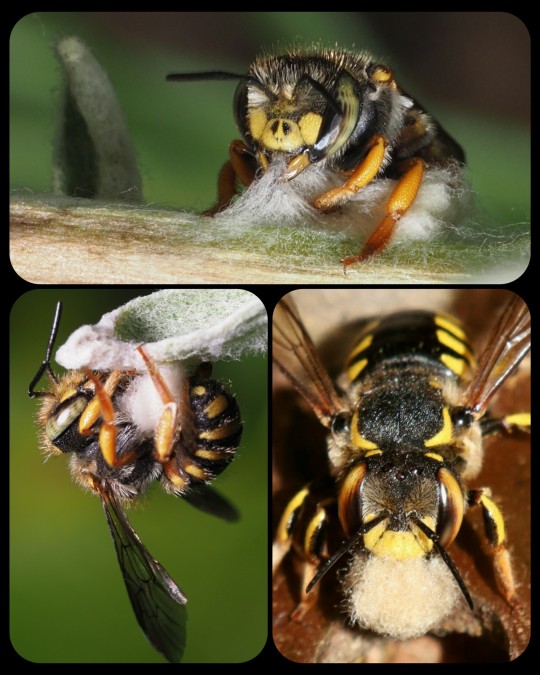
The fibers (known as trichomes) are collected from the leaves and stems of various plants, including lamb’s ear (Stachys byzantina), mulleins, globe thistle, rose campion, and other fuzzy plants.
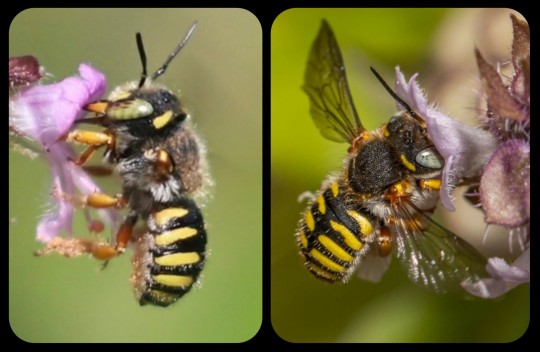
From the University of Florida's Department of Entomology & Nematology:
The female uses her toothed mandibles to scrape trichomes off fuzzy plants and collects a ball of the material under her abdomen. She transports these soft plant fibers to her selected nest site and uses them to line a brood cell. Next, she collects and deposits a provision of pollen and nectar into the cell, enough pollen to feed a larva until it is ready to pupate. Lastly, she lays a single egg on top of the pollen and nectar supply before sealing the cell. ... She will repeat this process with adjoining cells until the cavity is full.
These are solitary bees, meaning that they do not form colonies or live together in hives. Each female builds her own nest, and the males do not have nests at all.
Female wool-carder bees will sometimes sting if their nest is threatened, but they are generally docile. The males are notoriously aggressive, however; they will often chase, head-butt, and/or wrestle any other insect that invades their territory, and they may defend their territory from intruders up to 70 times per hour. The males do not have stingers, but there are five tiny spikes located on the last segment of their abdomen, and they often use those spikes when fighting. They also have strong, sharp mandibles that can crush other bees.
There are many different types of wool-carder bee, but the most prolific is the European wool-carder (Anthidium manicatum), which is native to Europe, Asia, and North Africa, but has also become established as an invasive species throughout much of North America, most of South America, and New Zealand. It is the most widely distributed unmanaged bee in the world.

A few different species of wool-carder bee: the top row depicts the European wool-carder, A. manicatum (left) and the spotted wool-carder, Anthidium maculosum (right), while the bottom row depicts the reticulated small-woolcarder, Pseudoanthidium reticulatum, and Porter's wool-carder, Anthidium porterae
Sources & More Info:
University of Florida: The Woolcarder Bee
Oregon State University: European Woolcarder Bees
Bohart Museum of Entomology: Facts about the Wool Carder Bee (PDF)
Bumblebee Conservation Trust: A. manicatum
World's Best Gardening Blog: European Wool Carder Bees - Likeable Bullies
Biological Invasions: Global Invasion by Anthidium manicatum
#entomology#hymenoptera#apiology#melittology#bees#woolcarder bees#nature#insects#arthropods#science#solitary bees#european woolcarder#anthidium#animal facts#cool bugs#cute animals
3K notes
·
View notes
Text
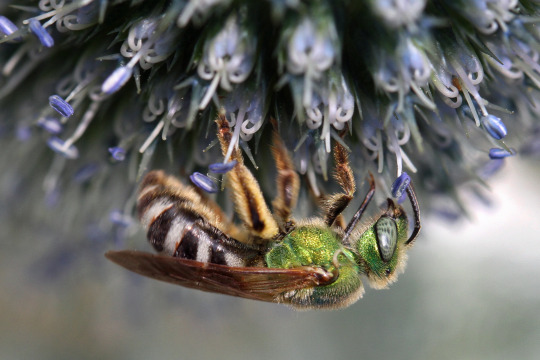
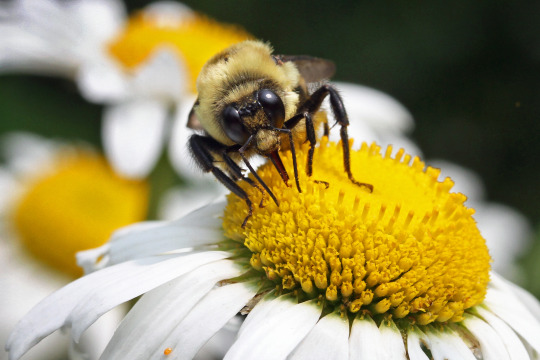
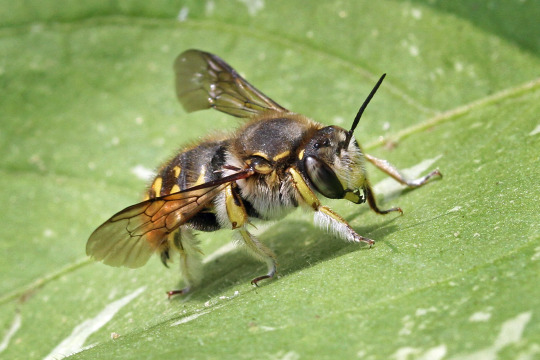
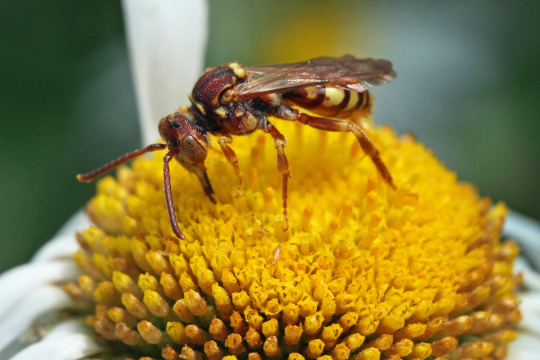

Went to a well-known public garden and found lots of wildlife on the flowers.
Bicolored Striped Sweat Bee (Agapostemon virescens)
Brown-Belted Bumblebee (Bombus griseocollis)
European Wool Carder Bee (Anthidium manicatum)
Nomad Bee (Nomada sp.)
Longhorn Bee (Melissodes sp.)
June 15, 2023
Southeastern Pennsylvania
203 notes
·
View notes
Text
November 5th, 2023

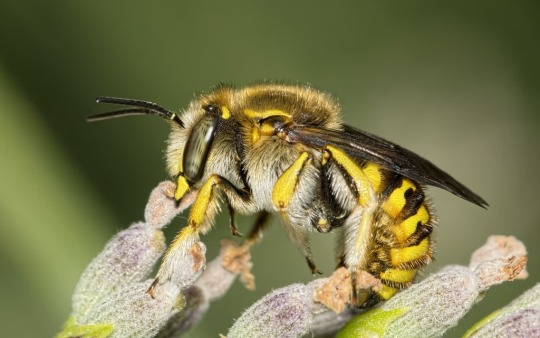
Wool Carder Bee (Anthidium manicatum)
Distribution: Native to Europe, Asia and North Africa; introduced to South America, North America, New Zealand and the Canary Islands, where it's invasive.
Habitat: Normally found in gardens, fields and meadows that contain their preferred plants, but also found in heathlands, woodland rides and clearings, wetlands, river banks,
Diet: Generalists; feed on the pollen from various flower families, with a preference for species found in their native distribution; prefer blue flowers with long throats.
Description: The wool carder bee earns its name from its behaviour of scraping the trichomes (or hairs) from the leaves of plants, creating little balls of hair that they use to line their nests, built into pre-existing cavities such as hollow stems and dead wood. Other materials used in nest-building include mud, resin, stones and leaves. The trichome bundles are fashioned into little cells, in which the female will lay an egg, along with a bundle of pollen and nectar for the larva to feed on after it hatches. Once all the cells are full, the cavity is sealed off with a terminal plug.
Male wool carder bees are extremely territorial and aggressive, both to other males of their species as well as other pollinators. This has two purposes: first of all, the male defends its ressources, which allows it to have ample food for itself, but a food-filled territory also attracts females for the males to mate with. When an uninvited guest comes to feed on a flower in the male's territory, the male will attack it with brief, aggressive tackles in order to shoo it away. If this isn't enough, the male will occasionally crush the enemy to death against its spiky abdomen (because this bee does not have a stinger!).
Here's a really cool video of a female wool carder bee harvesting trichomes!
(Images by Bruce Marlin and Pierre Bornand)
70 notes
·
View notes
Text

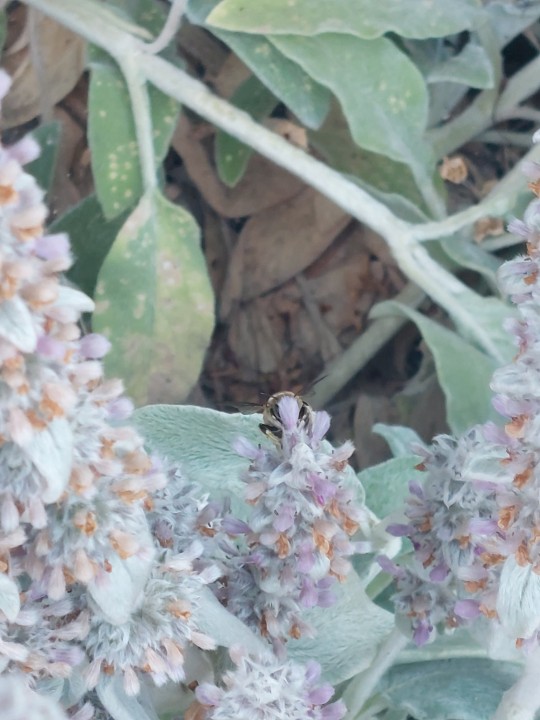
@smolskye submitted: hello mister bugperday! I was walking in Portland OR USA and found a wide variety of bees and wasps at these flowers. I recognized and searched up some western yellow jackets, euro honeybees, and multiple bumblebee species, but I can't find anything about this fuck off HUGE unit that accompanied them! i would say it was about 1 to 1.5 inches long. it was buzzing around so fast I could barely take a photo, and it kept landing on top of the other bugs, but it didn't seem to hurt them. do you have any idea what this large fellow might be? thank you!!
Love the implication that my first name is Onenice and my last name is Bugperday.
Anyhoo this fella looks like a European woolcarder bee, Anthidium manicatum. Despite the name they are indeed found in your location. They're called wooldcarders or carder bees because they strip the hairs off of the leaves like the ones you see in your photo and use it as nesting material. Males are also super territorial, and will attack any bugs in their territory, which is probably the behavior you saw with him landing on other bugs. Males can't sting, but they can bite and harass!
66 notes
·
View notes
Text
Bully Bee.
A male Anthidium manicatum demonstrating aggressive territorial behaviour by harassing a worker honeybee. (The honeybee survived it).
#Anthidiummanicatum#EuropeanWoolCarderBee#Salvia#Honeybee#Apismellifera#TerritorialBehaviour#Bees#Hymenoptera#Apidae#Megachilidae#Entomology
53 notes
·
View notes
Text
#2640 - Anthidium manicatum - European Woolcarder Bee

Accidentally introduced to many other parts of the world, where they've spread rapidly. They arrived in Aotearoa in 2006.
Best known for their habit of collecting the hair off particularly woolly plants like Lamb's-ear (Stachys sp.) - I'm pretty sure it's on a Stachys in the photo. The bundle is then carried back to their burrow to line the cell walls.
Unusually for a bee, the males are larger than the females, and highly territorial. This is probably related to the fact that the females are polyandrous, and the eggs are more likely to be fertilised by the sperm of her most recent mate. This is a strong evolutionary pressure to produce bees that can monopolise all the mates in their area, by driving off any rivals.
Lake Tekapo, Aotearoa New Zealand.
4 notes
·
View notes
Text






Algunas fotitos que tomé últimamente. 🇨🇱
Hylephila sp. - Anthidium manicatum - Vanessa carye - Yramea cytheris - Austroscaeva melanostoma - Toxomerus vertebratus.
Canon R7 + RF 85mm F2 Macro IS STM
4 notes
·
View notes
Text




european woolcarder bee, Anthidium manicatum, introduced species here
5 notes
·
View notes
Note
if u had to pick, what r ur top five favorite bugs ? 🐛
hi my love ^^ it's really hard to pick because I love so many >.< also I feel like we should count arachnids as well since "bug" is more of a colloquial, vibes-based classification that has expanded far beyond the Hemiptera order. That being said-
1. Vietnamese Lanternfly (pyrops candelaria) no not the invasive ones, though I have a tender place in my heart for them as well, this one is a beautiful snooty boi
2. Brood X Cicada (magicicada septendecula) for their beautiful eyes, their built in symbolism, and their personal significance to me
3. Rosy Maple Moth (dryocampa rubicunda) if I had to dress like one bug for the rest of my life it would be her
4. Golden Orbweaver (trichonephila clavipes) "Nephilia" means "fond of spinning", and if you've ever seen the webs these skinny legends make you'll know why
5. Wool Carder Bee (anthidium manicatum) I love all mason bees but there is something particularly charming about a bee collecting the fluff off of plants for a cozy nest
This was very difficult and I definitely left out some stars!! I'm gonna post before I give in to the urge to add a whole bunch of honorable mentions :3 questions for a bug boy
#asked and answered#I didn't even include any shield bugs!!#or weevils!!!#gah this is so difficult#I hope the bugs I didn't choose know I love them and don't have any hurt feelings#thanks for the hardest ask of my life babe sjsjsjsjsjs
3 notes
·
View notes
Note
Buzz buzz Trick or Treat!
trick or treat trick or treat! Anthidium manicatum, or the european wool carder bee, is one of my favorite kinds of bee! I love how they clip hairs off of plants (think fuzzy ones like lamb’s ear), roll them up, and use them to line their nests!!
here's a video of one doing her thing!
youtube
3 notes
·
View notes
Text
I haven't used this Apexel macro lens in a while. Getting proper focus is tricky. The depth of field is too shallow for use with medium to large insects. Now I remember why I rarely use it.
Wool carder bee Anthidium manicatum (Valencia, August 2024)
iPhone 15 Pro + Apexel macro lens
My other macros in:
https://www.instagram.com/mymacrominitips/
No usaba esta lente macro Apexel desde hace tiempo. Conseguir un enfoque adecuado es complicado. La profundidad de campo es demasiado escasa para usarla con insectos de tamaño medio o grandes. Ahora recuerdo porqué la uso poco.
Abeja de carda Anthidium manicatum. (Valencia, agosto 2024)

0 notes
Text

Anthidium manicatum - Continental Wool-carder bee (male)
We had two of these guys in our garden yesterday, the males are very territorial and I saw this one charge another mid air and tackle it to the ground. Apparently they'll fight just about anything they think looks like a threat, despite being males and not having stingers. Instead, they have four barbs on the end of their abdomen - arse spikes, if you will.

Another unusual thing about these gorgeous bees is that the males are actually bigger than the females, and they don't show any of the usual sexual dimorphism that I expect to see. I initially assumed this guy was a female before I ID'd him - typically males are smaller, thinner and have disproportionately long antennae.

0 notes
Text

okay, here’s the zoomed-in photo of the back. it is an Anthidium manicatum, common name wool carder bee. they collect fuzz! and have a loud buzz! size of a bumblebee but much more noticeable.

sittin'.
#lookit them fur pants#it is becoming Funky Bees Week#apparently these guys are invasive. aw.#insects#bugs#(general catch-all tag)
6 notes
·
View notes
Photo

Ridiculously cute, and only the second one I’ve ever seen.
European wool carder bee (Anthidium manicatum?)
July 29, 2017
Southeastern Pennsylvania
Introduced into the US around 1963 in New York State (If it is A. manicatum.)
#Anthidium manicatum#bee#bees#photographers on tumblr#wool carder bee#european wool carder bee#beeblr
372 notes
·
View notes
Text
Anthidium manicatum, Große Wollbiene, Cirsium oleraceum, Kohl-Kratzdistel


190805, 153700, Große Wollbiene

190805, 154300, Anthidium manicatum, Große Wollbiene, Cirsium oleraceum, Kohl-Kratzdistel
Anthidium manicatum, Große Wollbiene, Cirsium oleraceum, Kohl-Kratzdistel
Notizblog Naturbeobachtungen: https://wp.me/p9TZZ6-nf, …,
Systematik, Große Wollbiene
Ordnung: Hautflügler (Hymenoptera), Überfamilie: Apoidea, Bienen (Apiformes), Familie: Megachilidae, Gattung: Harz-…
View On WordPress
#(L.) Scop.#(Linnaeus 1758)#Anthidium#Anthidium manicatum#Apiformes#Apoidea#Arnó#Arno Beierlein#Arnulf Beierlein#Art: Große Wollbiene#Art: Kohldistel#Asteraceae#Asterales#Asternartige#Überfamilie: Apoidea#Bienen#Bienen (Apiformes)#Bildhauer Beierlein#Carduoideae#Cirsium#Cirsium oleraceum#Cynareae#Familie: Korbblütler (Asteraceae)#Familie: Megachilidae#Foto#Gattung: Harz- und Wollbienen (Anthidium)#Gattung: Kratzdisteln (Cirsium)#Große Wollbiene#Harz- und Wollbienen#Hautflügler
0 notes